

"The ship of a
thousand romances...."
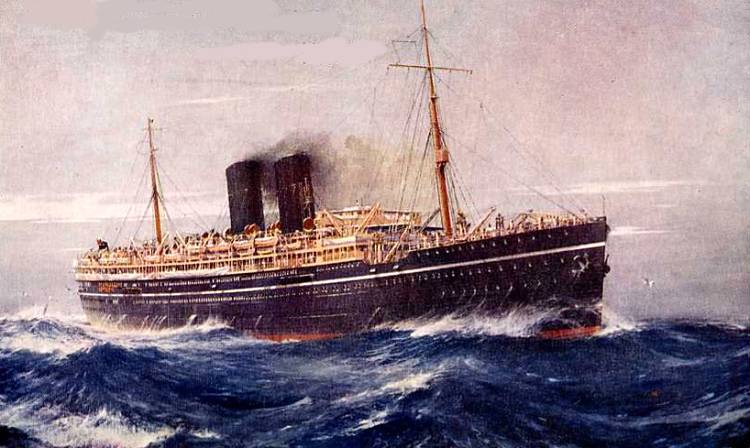
"In
that remarkable new liner, the Mooltan,' that Messrs. Harland and Wolff have
just handed over to the P. and 0. Company, and on whose trial trip from Belfast
to Tilbury I was privileged to be a guest, certain novel developments are either
already embodied or are foreshadowed."
Clough Williams-Ellis,The
Spectator, 27 October 1923
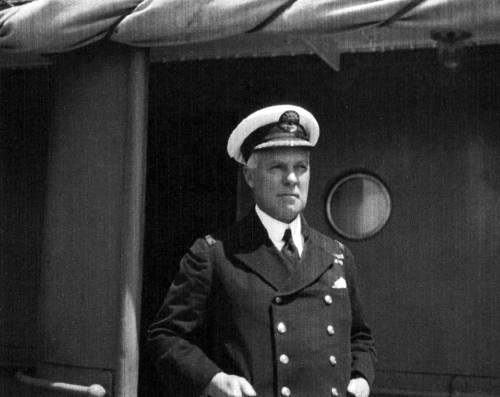
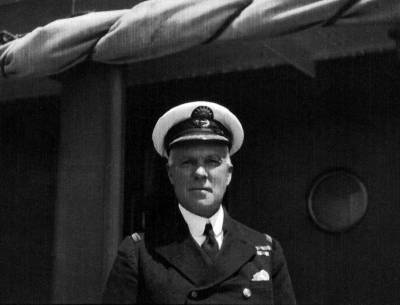
Mooltan's Captain, c1924,
taken at Sydney, Australia
"In brilliant sunshine
the new Mooltan passed up the Channel on Sunday and yesterday entered the
Thames, where she is one of the largest of the liners to be seen. She is a
notable new ship—the product of Harland and Wolff, of Belfast, and the property
of the P. and O. Of her class there can be nothing finer afloat in the world
to-day. She represents the matured experience of famous British builders and
owners, and she indicates the confidence of the P. and O. Company in the future,
at a time of deep depression for the whole shipping industry.
Her name recalls a ship
destroyed by the enemy during the war; but she is more than twice the size of
the Mooltan sunk by torpedo off Sardinia six years ago. Her two black funnels
and the buff colour of her deck work proclaim her P. and O., yet she is much
larger than any ship that has yet flown the house-flag of the line. Of 21,000
tons gross and with her seven decks and cruiser stern, she looks what she is - a
British liner of the highest type built for the Eastern and Australian services.
Rounding Land's End from
the Irish Sea and the Atlantic, and riding high, with no cargo in her holds, the
new Mooltan had the first taste in her career of strong wind and heavy sea. The
spray dashed up and salted the bridge, but, little troubled by wind or sea, she
ploughed steadily on, and from the Eddystone to Prawle Point she was set to snow
her paces, while men who had planned and fashioned her and all the machinery in
her studied every feature of the response, and did not find her wanting.
The Mooltan will be the
largest ship specially designed for her service to pass through the Suez Canal.
But the distinction will soon be shared, for the Maloja, a sister ship of the
line, is next month to leave Belfast for the Thames, and then will follow the
Mooltan to the East.
The Mooltan is 625 ft.
long, with a; breadth of 73 ft. and a depth of 44 ft. , and bears two masts.
Eleven bulkheads divide the ship into twelve watertight compartments, and the
double bottom extends right fore and aft. The vessel was built under the special
survey of Lloyd's Register with a view to receiving the society's highest class.
Accommodation is provided for 327 passengers in the first-class saloon and 329
in the second saloon, and there are lofty and comfortably-furnished public
rooms. Square cot-beds are fitted in every first-class cabin. Each room has a
window - to the sea, and most of the rooms are designed for one passenger only
or for two passengers. The majority of the cabins in the second-class are for
two travellers only.
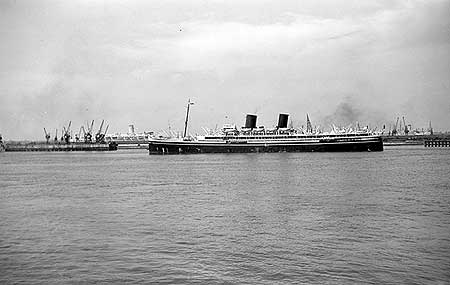
The liner is propelled by
twin screws driven by
two sets of inverted, direct-acting, quadruple expansion
engines,
balanced on the Yarrow-Schlick and
Tweedy system. Steam is generated in six double-ended and two single-ended
boilers having a working pressure of 215 lb. per square inch. Oil fuel is used.
From the chart-room are controlled the latest approved mechanical devices for
the safety of the ship. Electricity is employed in these, and also in the
elaborate arrangements which provide for the comfort of the
passengers. A series of rooms is set aside for the different Eastern mails, and
ship's store-rooms, baggage-rooms, and refrigerated holds absorb more space than
would be imagined from a survey of the upper decks.
The
New P&O Liner ~ From The Singapore Free Press & Mercantile Adviser 25 October
1923
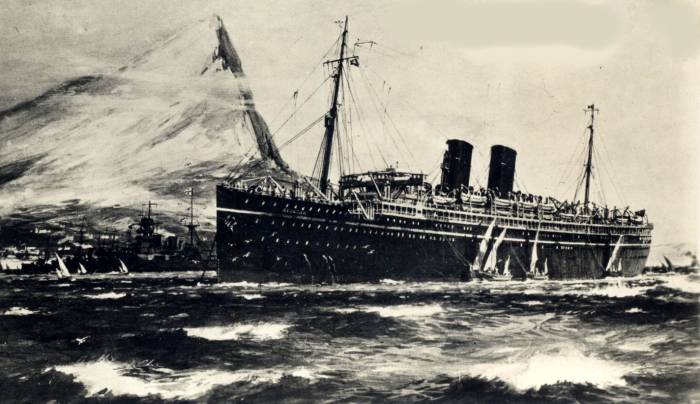
Mooltan
was unusual in combining both
quadruple-expansion steam engines
and
turbo-electric transmission.
When completed in 1923 she had quadruple-expansion engines, but in 1929,
turbo generators and
electric propulsion motors were added, in order to increase her speed. She had
broad decks and a reputation for great steadiness, but speed had been sacrificed
for reliability and comfort. Mooltan had a small
rudder for a ship of her
size, and this impaired handling. She originally had two
funnels, but the second
was a dummy that served as an engine room ventilator. Reduced in size in order to
accommodate a main armament of 6-inch guns during WW2, when she initially saw
service as an Armed Merchant Cruiser, it was later reinstated, to its full glory, when she was converted to a troopship role.
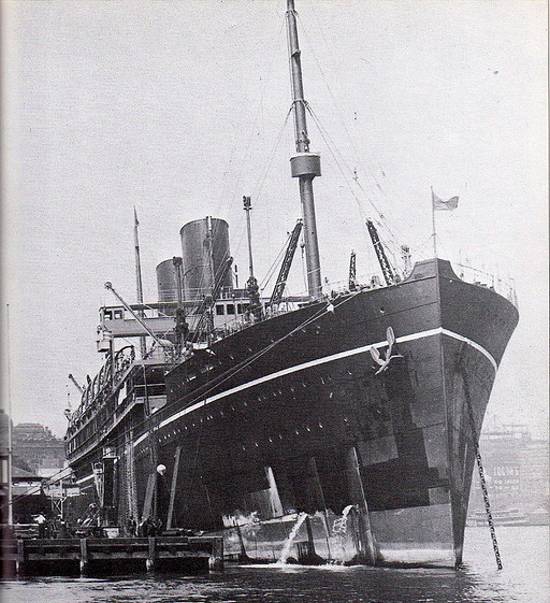
An extremely popular ship in Sydney
between the wars, Mooltan is seen here alongside the P & O terminal at Circular
Quay.
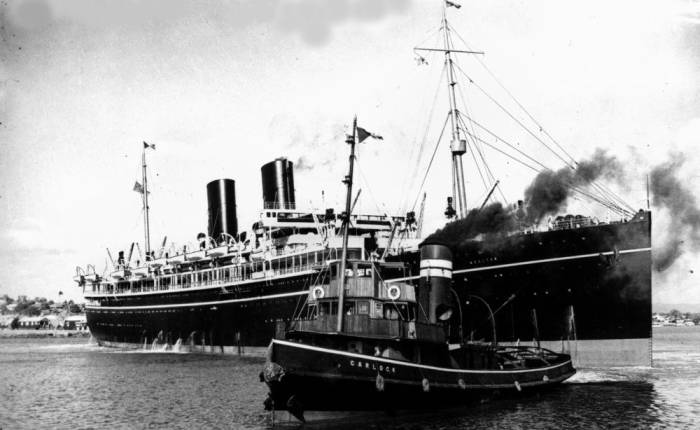
Ordered on 29th November 1918, from
Messrs. Harland and Wolff of Belfast,
Mooltan was the third P&O passenger
ship to bear the name. She was launched on 15th February
1923, undergoing
a series of successful trials in Belfast Lough on September 21 1923. Lord
Inchcape. the chairman, and the directors of the company embarked in her the
following day, accompanied by Lord Pirrie, chairman of Messrs. Harland and
Wolff, and chief officials of the P. and 0. and associated companies. She then
left for Tilbury Dock, where she arrived at 9 a.m., punctual to schedule, on
24th September.
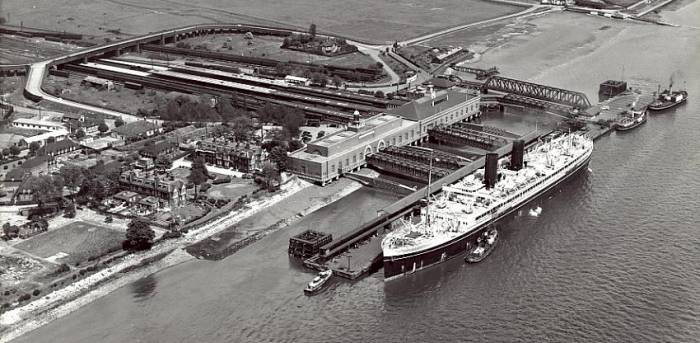
"Her behaviour in a hard blow and a high sea when rounding Land's End ,
demonstrated her to be a beautifully steady ship, with a minimum of gentle
movement at any wave angle; in quieter weather one might have been ashore, so
imperceptible was her motion, an entire absence of vibration, both during an
hour's sea run at full speed and when going at more moderate paces. Commanded by
Captain S. Finch, O.B.E., R.N.R, she is programmed to sail for Bombay on October
5, and will be followed a month later by her sister ship, the Maloja."
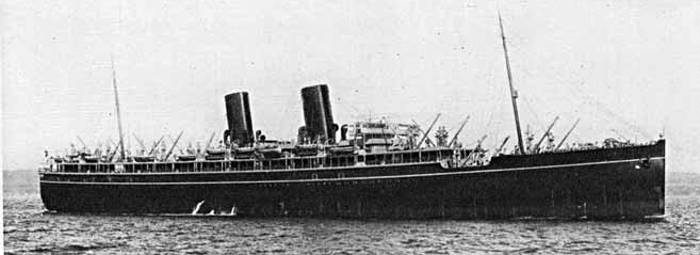
The Mooltan marked a new phase in the development of the P&O fleet. A
ship in the trade to Australia via Suez that could house, dine and sleep in
approved comfort, six-hundred and fifty six saloon passengers, on levels two
tiers or more above the main deck, in size, above the average to which the trade
was accustomed.
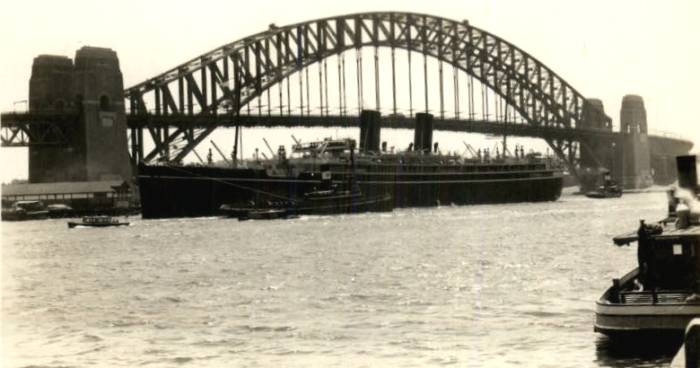
Mooltan
was
the largest ship in the trade, and the largest designed to pass through the Suez
Canal. In size, 21,000 gross tons,, she equalled the moderately big ships of the
Atlantic.
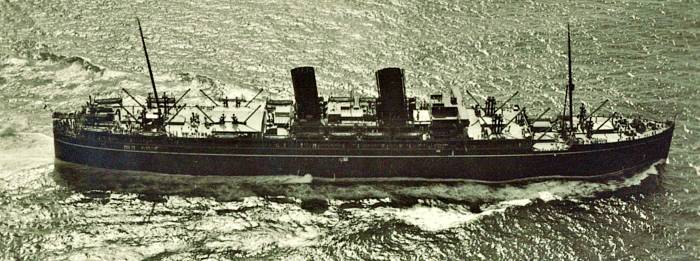
"
She
is a noble looking vessel, a typical P. and 0., and re-produces in her visible
lines that roundness or softness of contour which, as old, travellers to Sydney
will remember, so notably distinguished the two Belfast ships of the'
eighteen-eighties, the Arcadia and
Oceana. This absence of anything approaching
sharpness of line is accentuated in the Mooltan by her cruiser stern. A notable
feature of the vessel is the excellence of her second saloon accommodation,
which shares the advantages of the first-saloon in that all cabins are porthole
cabins, and that the broad central fore and aft spaces on the bridge, and
shelter decks dividing the port cabins from those of the starboard side, are
filled by continuous ranges of bathrooms and offices. No one, therefore, need go
far for a bath."
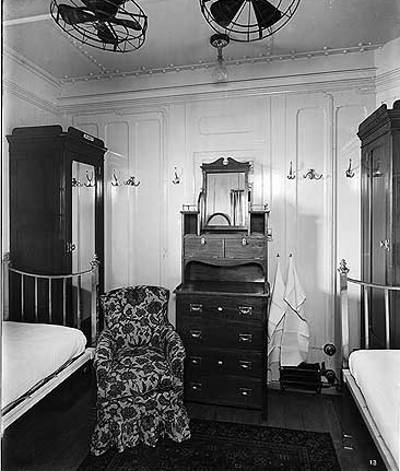
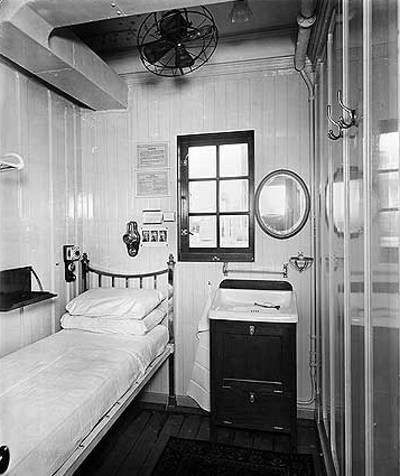
There are berths for 327 first and 323 second-saloon passengers.
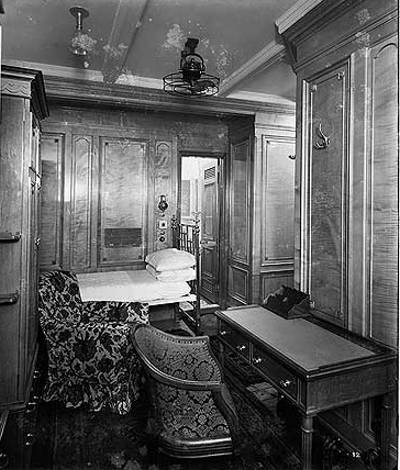
"The great length of 625 feet and beam 73 feet, resulting from the Mooltan's
huge tonnage has rendered possible a very compact, roomy and convenient
arrangement of her passenger accommodation, and full advantage has been taken of
this in the ship's design.
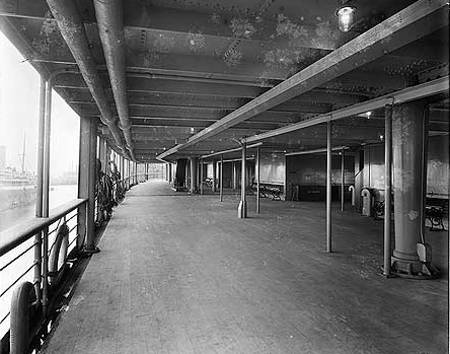
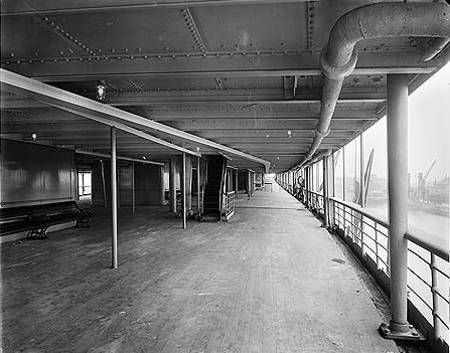
In broad outline, the forward portion of the promenade deck, sheltered over the
full extent of its length by the boat deck above, is occupied by a range of
roomy single-berth and two-berth cabins, and bathrooms.
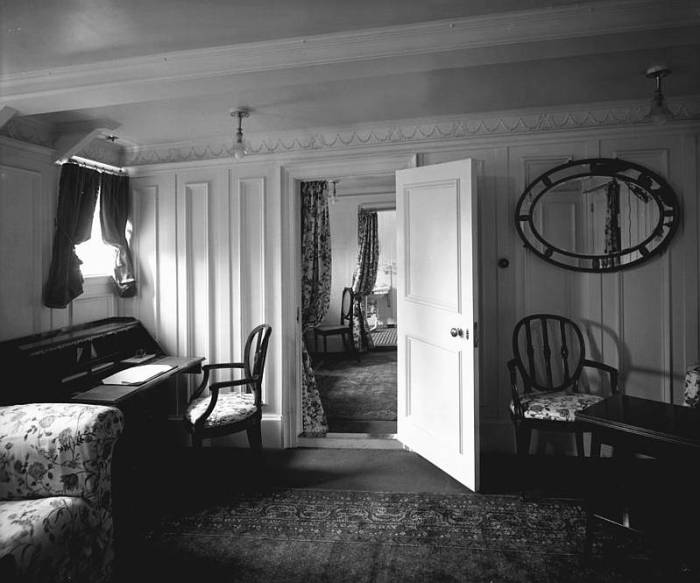
among which are four suites, panelled in sycamore and finished in Louis XVI
style, each with a private bathroom adjoining.
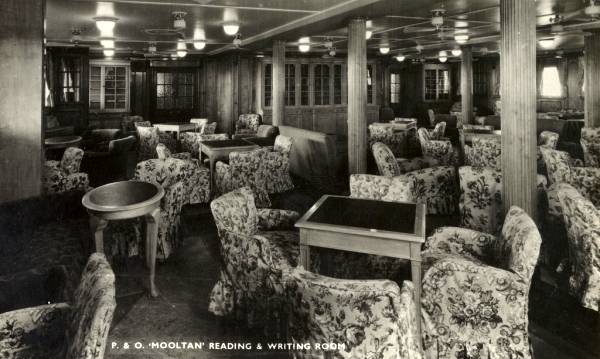
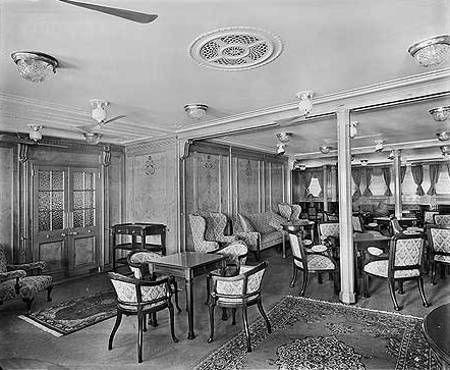
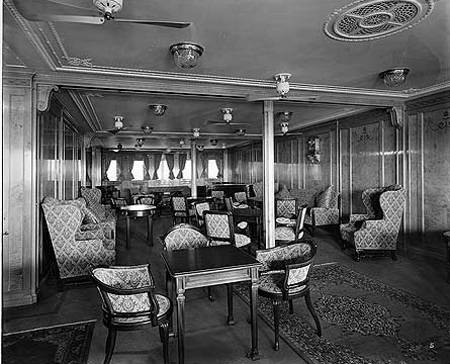
Abaft these cabins is the first-saloon reading and music saloon – a pleasant
apartment, panelled and framed in sycamore, stained silver grey, the furniture
consisting of easy-chairs, settees, writing tables and an excellent grand piano.
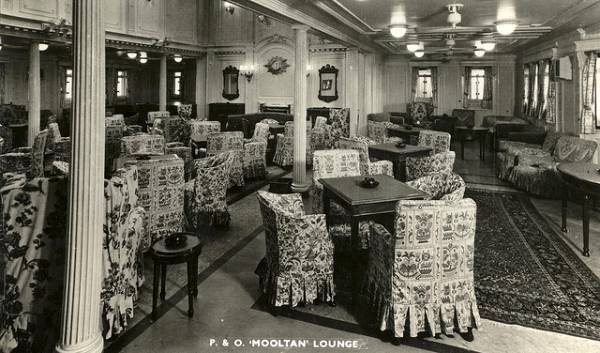
Abaft of and detached from the music room is the first-saloon lounge or divan.
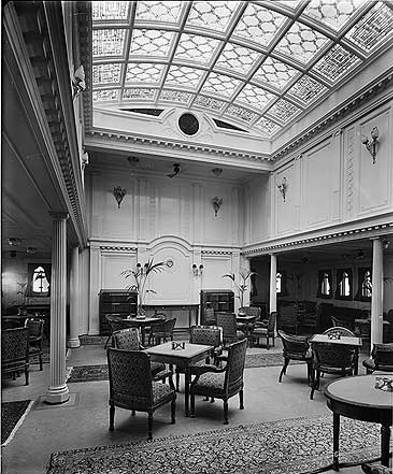
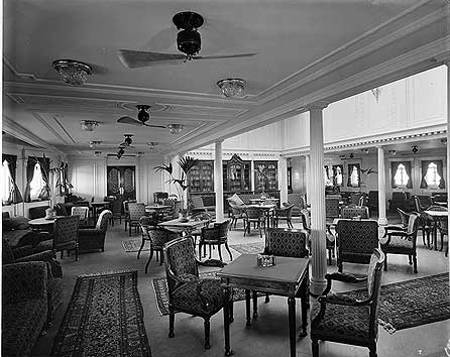
The plan of this saloon provides a number of corner spaces in which are tables
with comfortable seats for bridge or other uses.
The lounge in lighted on either side by eleven big French windows opening on to
the deck and a stained glass roof is carried up to a height of 22 feet. Few
similar rooms in the best hotels are larger or loftier; none can be more
pleasing. The walls are panelled in ivory white.
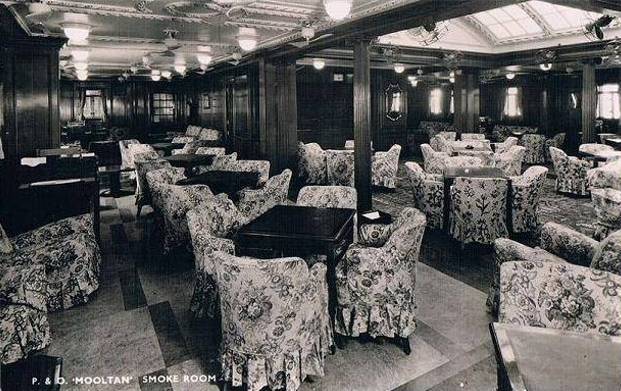

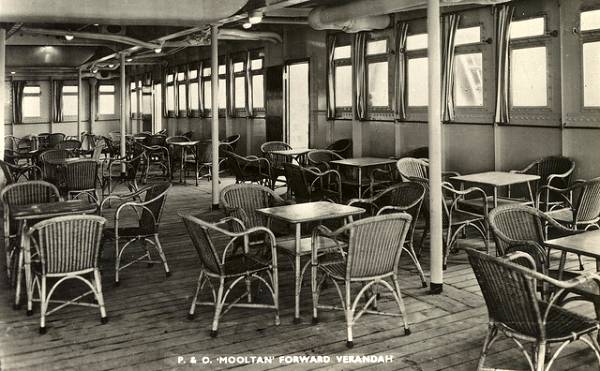
Access is had at the after end of the smoke-room to a sheltered veranda, with
seats, tables and wicker furniture, which forms one of the ship's special
attractions.
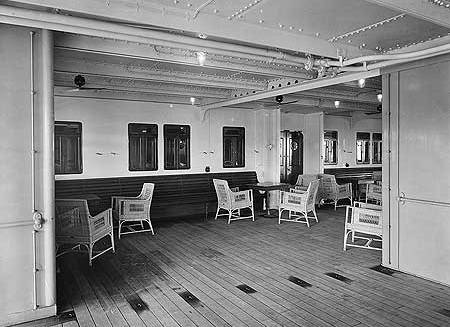
The after part of this deck affords a wide promenade for second
saloon passengers, and throughout the promenade deck’s length, from the cabins
forward to the second promenade aft, stairways, conveniently placed, lead to the
decks below.
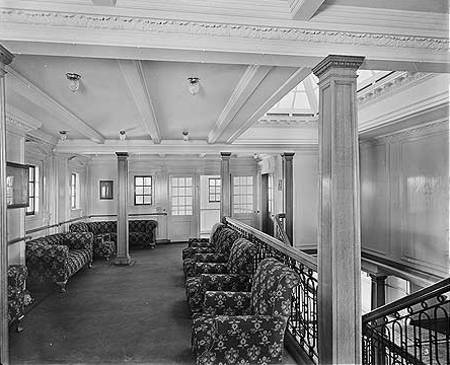
The bridge deck is, as to four-fifths of its length, occupied by passenger first
and second saloon cabins. Those of the first-class are arranged in three-tiers,
each receiving air and light from its own porthole, These tiers consist
respectively of three-berth cabins in pairs, arranged about an inner pair of two
berth cabins, these again enclosing, centrally, a single-berth cabin, all being
entered from a short central alley-way The same arrangement exists in the
second-saloon portion, with the exception that the first pair of the series are
four berth cabins, the second pair and the cabin centrally placed being each
arranged for two occupants,
At the after end of this deck and adjoining one another are the second-saloon
smoking and music saloons, both of ample dimensions; with comfortable furniture;
and pleasingly walled in pine, finished white, and mahogany respectively. On
this deck are also the surgeon's cabin, dispensary and the hospital cabins,
with, of course, their own bathroom en suite, all fitted in accordance with the
best and latest practice at sea. The sick quarters are completed by a pair of
isolation hospital cabins, bathroom and offices at the extreme after end of the
boat deck.
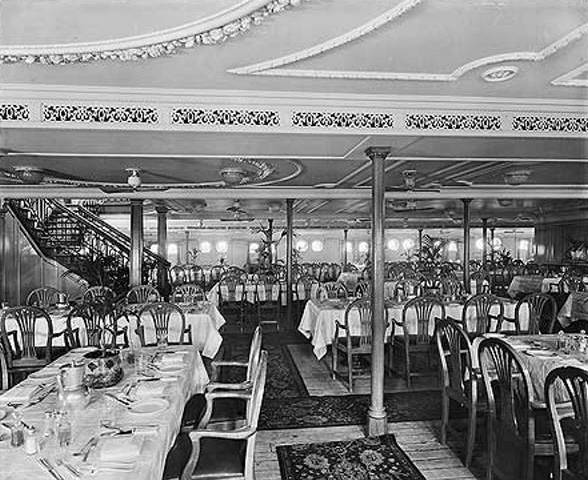
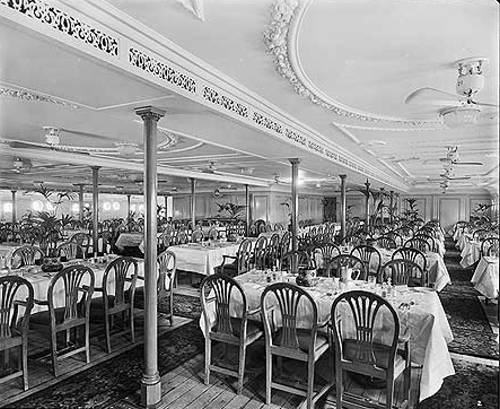
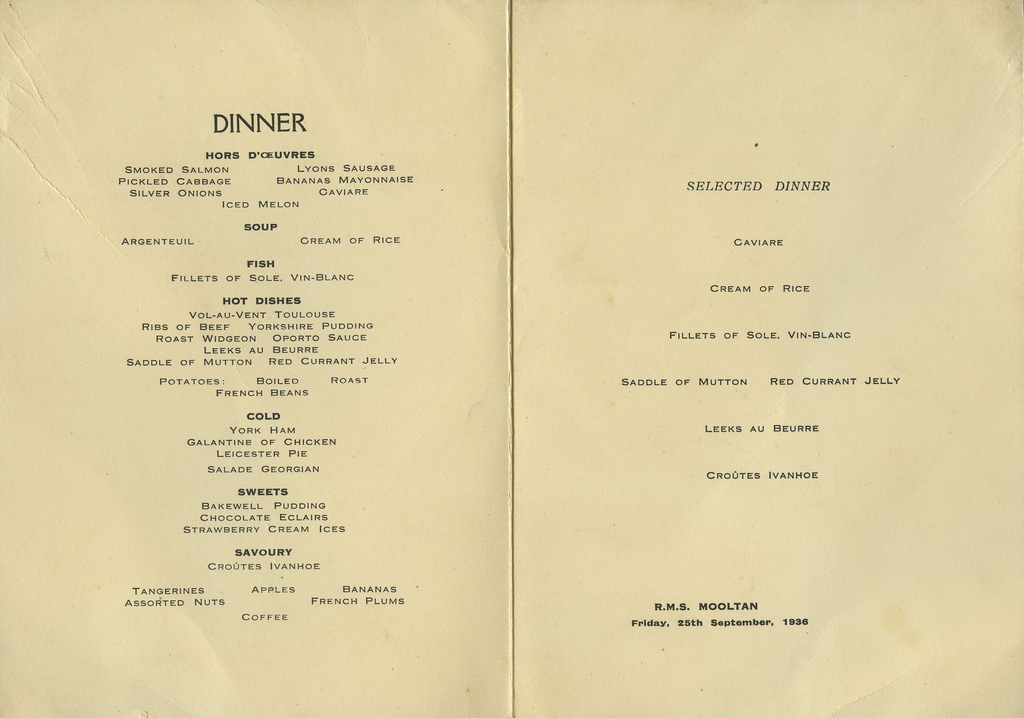
Midway on the shelter deck below, and filling half its length are the first and
second dining saloons, with galleys, pantries and service rooms conveniently
placed midway between them. The first dining saloon, receiving natural light and
air on both sides from 36 large portholes, has seating accommodation for 330
passengers, with tables usually arranged for four or more persons on the
restaurant plan. The room is plainly but pleasingly panelled in the Georgian
style and finished throughout in ivory white.
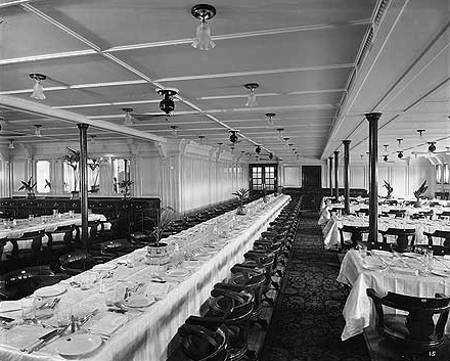
The second-class dining saloon is also
finished in ivory white with a mahogany dado; and here, again, the tables are
planned, restaurant fashion, and the saloon lighted and aired on either side by
large portholes, arranged in pairs.
Forward of the first dining saloon are more first-class cabins also arranged on
the three-tier or tandem plan, all with outside portholes, and with plenty of
bathrooms amidships; aft of the second dining saloon are triple-tiered cabins of
the second-class on the port and starboard sides, again with ample bath
accommodation amidships.
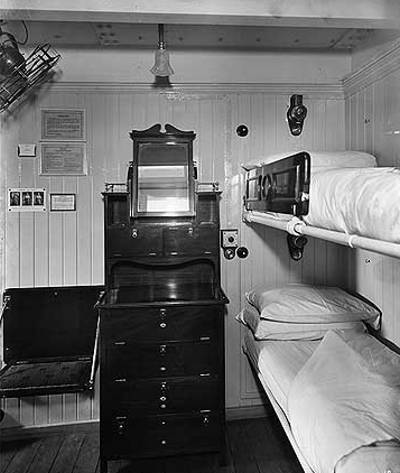
The cabins include in the first-class a large number of single berth rooms
while the majority of the second-class cabins contain two berths only. The ship
has 3,000 electric lights and, moreover, possesses 1,000 bells which, together
with an efficient system of telephones, ensures prompt communication between all
her parts. The cabins are fitted with electric heaters which are under the
passenger's control; and the public rooms also are electrically heated. Each
cabin has a powerful electric fan of graduated speed and there is a reading lamp
at the head of each bed in addition to the ordinary cabin lighting.
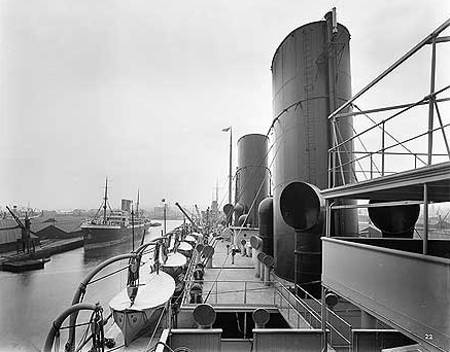
"The Mooltan has two elliptical funnels of somewhat remarkable dimensions and two
pole masts. She is divided by eleven bulkheads into twelve watertight
compartments and her double bottom, consisting of oil and water ballast tanks,
extends throughout her entire length. She has, like other ships of the fleet to
which she belongs, large mail, bullion and baggage rooms and insulated store
rooms for the carriage of her provisions, and her holds also are insulated for
the carriage homewards from Australia, the large quantities of refrigerated
produce which she will be capable of stowing."
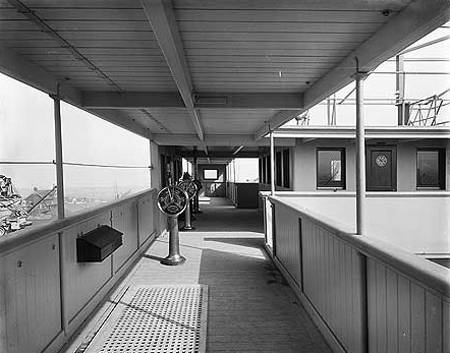
Mooltan's navigation bridge is spacious and spans the entire 75 foot breadth of the ship.
"She is propelled by twin screws, actuated by two sets of inverted,
direct-acting, quadruple-expansion engines. balanced to eliminate vibration, on
the Yarrow-Schlick-Tweedy system, and driven by steam, at a working pressure of
215 lbs. to the square inch, from six double ended and two single ended
cylindrical boilers whose furnaces burn oil fuel under forced draught. The
condensers are of the three-flow type with independent air and circulating
pumps, electrically driven, and the auxiliary machines all work independently of
the main engines. The engine and boiler rooms are ventilated by powerful
electric fans."
"The quality in the Mooltan which will form her chief claim to public approval is
one which has been built on the practice of former years and is the product of
the conservatism and experience which are the foundations of the P.and 0.
Company's building policy. That quality may be said to consist of a combination
of comfort, elegance and efficiency. She is a remarkable vessel and her advent,
and that of her sister the Maloja, in Eastern and Australian waters will be
awaited with a good deal of interest. "
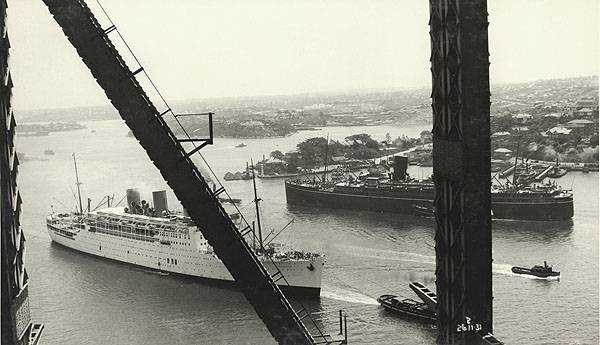
"In that remarkable new liner,
the Mooltan,' that Messrs. Harland and Wolff have just handed over to
the P. and 0. Company, and on whose trial trip from Belfast to Tilbury I
was privileged to be a guest, certain novel developments are either
already embodied or are foreshadowed. The introduction of oil
firing has, of course, done away with the great streamer of smoke that
we had come to think of as almost part of a steamer. It has, too,
abolished all the devastating horrors of coaling ship, and most of the
rigours and macabre picturesqueness of the stokehold. But what is really
upsetting, is to find that the brave array of gigantic funnels is an
obsolescent feature. In the Mooltan, one funnel more than suffices to
carry off the invisible fumes from its six great boilers, the second one
having been found a more or less honorary job as an engine-room
ventilator! As a layman and a landsman I had believed that turbine
engines were 'the thing', but the Mooltan has inverted, direct-
acting, quadruple-expansion engines, balanced to eliminate vibration
on the Yarrow-Schlick-Tweedy system. Whatever that system may be, it is
singularly successful, for I never put to sea in a ship so free from
noise or tremor, and that though we did some trial sprinting at over
18-knots. I believe the pride of the Mooltan, so far as her engineering is concerned, is her steering gear,
a thing of great fat pistons that move ever and again at the will of the
far-off helmsman, turning the huge rudder through a fraction of a degree
or its whole traverse, its obedient response being automatically and
instantly signalled back to him - an electrical 'Aye, aye, Sir!'
But it needs an engineer to
write of these high matters. As
a plain man; it was the internal planning of the ship; both generally
and in detail, that struck me most, and struck me very favourably. Gone
are the stuffy cabins with 'borrowed lights'; all here have direct
and ample ventilation. The accommodation of the crew and staff, both
officers and men, is beyond criticism. The usual glaring contrast
between passengers' quarters and those of the ship's company is indeed
conspicuously absent, though it is in part accounted for by the
plainness of the former. After the opulent display of some of the latest
Atlantic liners, the almost Puritan simplicity of the Mooltan is a
surprise - by no means unpleasant. But one wishes the designers had had
the courage of their convictions and gone 'all out' on unadorned constructionalism
- severe and chaste - if that was their way. As it is, it
looks rather as though there had been last minute misgivings about what
saloon passengers would expect - and that a little architectural
dressing-up had been hastily improvised. Now, it is one of the
accepted marks of good architecture that trite and meaningless
architectural trimmings are eschewed, whilst the distinctive thing about
ordinary sea-going architecture is that they are elevated into a sort
of blasphemous 'style,' the hyphenated style of the dining- car and the overmantel; in short, architecture at sea. The clean, stark,
uncompromising efficiency of the engine-room does not constitute 'art',
but it can at least satisfy one in a way impossible to art on a low
level. I do not say that such architecture as is attempted in the Mooltan is a bad example of its kind (I have seen countless worse!),
but it is not of a very distinguished kind. It may no doubt be said, and
justly, that people sail by P. and 0. steamers to journey swiftly and
comfortably to India and elsewhere and not to contemplate the
decorations. Nothing could be truer, but to sit for weeks opposite a
column or a moulding that might as well have been right, and which is,
in fact, just wrong, can please no one and will actively distress some.
If there had been a " Remarks
Book' on board the Mooltan,' I might have rounded off my appreciation
with a few impertinent questions - chiefly because I am insatiably
curious, but also to convince my hosts that my general praise was not
merely the flattery of a well-conducted guest. Why, for instance, are
the Mooltan's coffee-coloured Goanese waiters dressed in skimpy black
instead of in Bakst-like*liveries that would transform the prim and
almost bleak saloon into a festival of moving colour? Why is there no
kind of nursery to alleviate the anxiety and sufferings of the
travelling parent, and why is there no hot water laid on either to the
cabins or lavatories? But the P. and 0. Company probably knows what it
is about as well as any other shipping company in the world - perhaps
better- and I dare say it has tried and since discarded these and many
other vanities for good and sufficient reasons.
Clough
William-Ellis,The
Spectator, 27 October 1923
* NOTE: Here, the writer is
referring to Léon Bakst, born in Russia in 1866, who belonged to that
young generation of European artists who rebelled against 19th century
stage realism, which had become pedantic and literal, without
imagination or theatricality. There were no specialist trained theatre
designers, so painters like Léon Bakst turned their painting skills to
theatre design. Bakst’s fame lay in the ballets he designed for the
Diaghilev Ballets Russes, and huge pageant spectaculars for dancer and
patron, Ida Rubinstein.
The Peninsular and Oriental Steam Navigation
Company placed the order for RMS Mooltan with Harland and Wolff Ltd on 29
November 1918. On the same date, an order was placed for her sister ship RMS
Maloja.
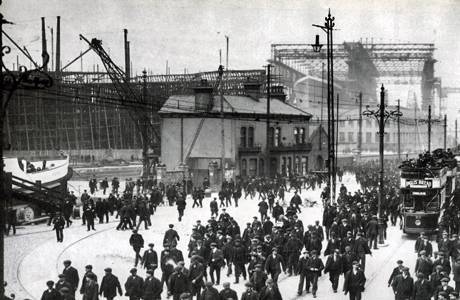
RMS Mooltan was given the yard #587 and work
began on her in December, in the Belfast shipyard.
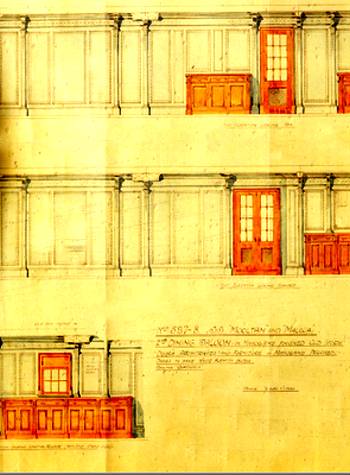
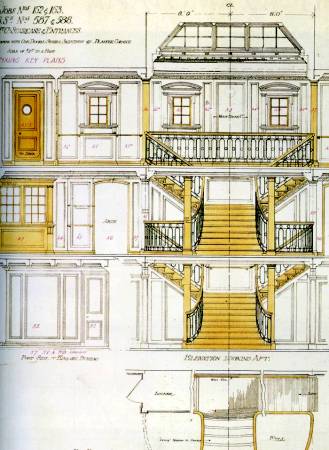
She was launched on 15 January 1923. She
was then put through her sea trials and was finally delivered on 21 September
1923. At that time she was the first P & O ship over
20,000 tons, but she had sacrificed speed for reliability and comfort. The Mooltan had broad decks and would have a reputation for magnificent steadiness,
although, because of her small rudder, handling would prove to be difficult.
Mooltan set off on her maiden voyage on 5 October 1923. She left the Port
of Tilbury, and via Suez canal arrived in Sydney, Australia on 21 December 1923,
calling at Colombo, Ceylon and Melbourne on her way. She would make
the voyage to Australia many times carrying many thousands of immigrants to a
new life in Australia.
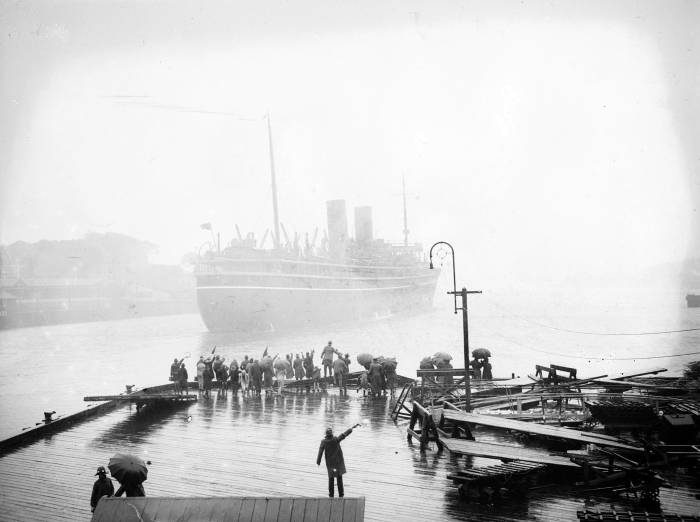
Photo: Australian National Maritime Museum's
Samuel J. Hood Studio collection. Sam Hood
(1872-1953) was a Sydney photographer with a passion for ships.
In 1929 SS Mooltan
was refitted with new engines, namely, two British Thompson Houston
exhaust-driven electric turbines and motors with the effect that her top speed
was increased to 17 knots (31 km/h). Her passenger accommodation was
also extensively refurbished.
In 1931 she was again in the shipyard
- and once again, her accommodation was significantly improved.
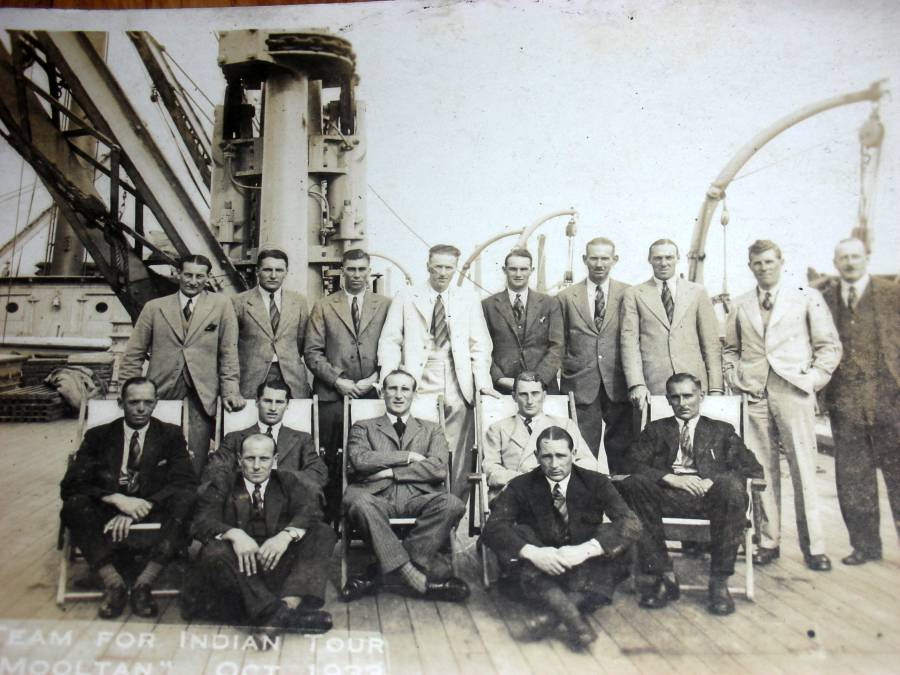
In 1933 she carried Douglas Jardine’s MCC cricket test
team to India.
Photo: Anndrew
Collier
In
1938 alterations were made to the ship which allowed her to carry chilled beef.
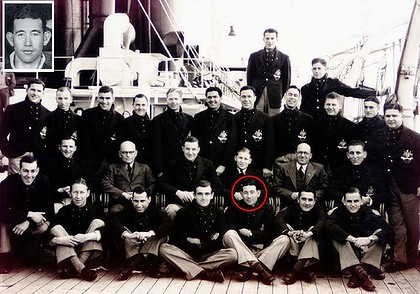
"There was a sense
of excitement and a spirit of adventure as the members of the 1939 Wallabies -
described by rugby correspondent ''Sol Plex'' as a "husky band of 29" - boarded
the Mooltan on July 21 for their voyage to Britain. The feeling was that the
triumphs and glories to be achieved during their 10-month, 28-match tour would
provide them with endless ''war stories'' to tell their grandchildren. Billy
Hughes, Australia's prime minister during World War I, farewelled them and he
recalled the time he watched an Aussie army rugby team beat France in Paris
after the Great War and a Digger - either uncaring or oblivious to Hughes's
position - passed on a half-hearted request for "some little bloke" to enter the
dressing room to join the celebrations. The prime minister was initially refused
access!"

Australian Wallabies
rugby team training at sea en route to England in Mooltan, 1939 The ship
docked at Southampton on the day England declared war and after a couple of
weeks spent filling sandbags to kick-off the war effort, the squad set sail for
Australia having not played a game.
Source: The Sunday Morning
Herald - Rugby heaven
Mooltan:
Callsign
GFBC -
Goes to War
After the outbreak of the Second World War, Great Britain and her allies
realised that they would need ships for troop and equipment movements. On 6
September 1939, Mooltan was requisitioned for service as an armed merchant
cruiser and was converted for such a task.

Part of the conversion was the reduction
in size of her second funnel, which was in any
case a dummy used to ventilate the engine room below; this was done to improve
the arc of her anti-aircraft guns. Later on, the funnel was replaced
in its original form.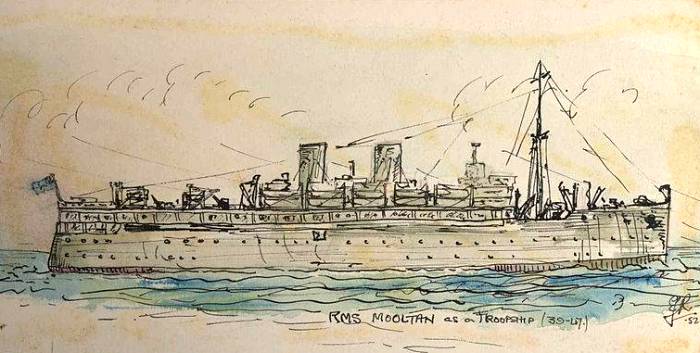
Armament
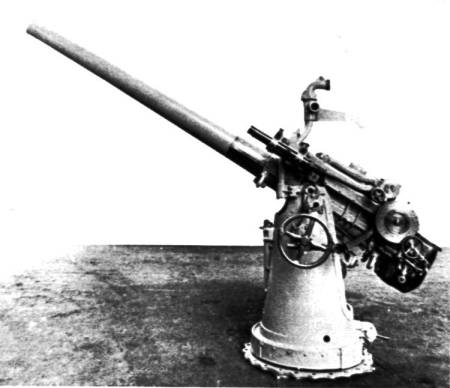
Eight - 6inch CP XIV Single Barrel - Rate of Fire 7 Rounds
per Minute - Max Range 25,000 yards
Two - 3inch QF HA Mark I Single Barrel Anti-Aircraft Gun -
Rate of Fire 20 Rounds per Minute - Max Range 7,000 yards
One
40mm Anti-Aircraft Gun + Ten 20mm Type 33 Anti-Aircraft Guns + Four .303
Hotchkiss machine guns.
Plus One
barrage balloon and a rocket launcher.....
Sensors

Radar Type
272, Surface Search - Range 25 Nautical Miles
As an armed merchant cruiser, Mooltan served in the South Atlantic, based
on Freetown, Sierra Leone, where she had the satisfaction of not losing a single
merchant ship placed in her care.
Career:
October 39 - April 40: South Atlantic Station
May 40: Freetown Escort Force
June 40 - July 40: South Atlantic Station
August 40 - January 41: Freetown Escort Force
|
MOOLTAN |
|
|
|
|
|
|
|
Date convoy sailed |
Joined convoy as escort |
Convoy No. |
Left convoy |
Date convoy arrived |
|
|
|
|
|
|
|
05/02/40 |
05/02/40 |
SL 019F |
17/02/40 |
20/02/40 |
|
01/03/40 |
01/03/40 |
SL 022F |
12/03/40 |
15/03/40 |
|
07/04/40 |
07/04/40 |
SL 027 |
21/04/40 |
24/04/40 |
|
25/06/40 |
25/06/40 |
SL 037 |
09/07/40 |
12/07/40 |
|
10/09/40 |
26/09/40 |
SL 047 |
30/09/40 |
28/09/40 |
|
18/10/40 |
18/10/40 |
SL 052 |
05/11/40 |
05/11/40 |
On 31 July 1940, Mooltan was
in the western approaches en route from Plymouth
to Freetown, when she was attacked by a German reconnaissance aircraft;
fortunately she
survived intact.

Naval ratings
celebrating Christmas Day on board Mooltan, c1940
To War Against the
Vichy French.
Operation Torch, the
British-American
invasion of
French North Africa
commenced on 8th November 1942, and was designed to clear the
Axis powers from North
Africa, improve naval control of the
Mediterranean Sea, and
prepare for an invasion
of Southern Europe in 1943.

"On
October 22 we entrained at London for Bristol and there embarked on I IMS
Moolian which sailed to rendez vous with the North African invasion convoy then
forming in the Firth of Clyde. Knowing that D-Day in North Africa was scheduled
for November 8th, I heaved a sigh of satisfaction and settled down to a complete
rest for the ocean voyage! This was not to be, however. The commanding
officer of troops on board the vessel. Brig. Gen. Dunn, broke it to me. none too
gently, that I was now appointed ships gunnery officer! After a brief conference
with the ships captain, I was startled to learn that there were just two British
marines available to man the ship's guns and that I would be required to furnish
the balance! To use airman's phraseology, "There I was . ." with no artillery
troops aboard ship' All the equipment was British, which didn't make any real
difference since we would have to start our gun crews from scratch anyhow - and
it didn't matter what brand of equipment we trained on! It was mandatory that
the guns be manned twenty-four hours each day, and the manning crews called for
a strength of 174 men. I selected these men from the 815th Engineer Battalion as
some of these had received some training on machine guns. With all available
fingers firmly crossed, I undertook the task of making AAA gunners out of
Engineer troops. Upon arrival at the rendezvous point, we joined the balance of
the convoy and our days and nights were under heavy pressure to train the
engineers in the art of gunnery. Our defense also included one barrage balloon
and one rocket launcher.The two British marines worked out splendidly. They were
tireless in their efforts to train the Americans on these weapons and they
themselves were detailed as gun pointers on the six-inch guns.
At 2300
hours on 26 October, the convoy commander decided to celebrate my birthday by
moving down the Firth of Clyde to open sea, and thus the voyage to Africa began.
Our gunners were making rapid progress and we were looking forward to indulging
in considerable firing practice. Because of its speed and armament, the Mooltan
had been employed as an auxiliary cruiser and was accordingly assigned to the
left rear flank of the convoy, an exposed position which would call for heavy
shooting in the event of enemy attacks. It also offered a broad expanse of open
sea for gunnery practice, with no particular danger to the other elements of the
convoy! Considering the fact that the men had never fired AAA guns, they did
remarkably well in practice. Since this was not Fort Bliss with plenty of towed
target missions available and no other target that could be considered suitable,
we fired several short bursts from the three-inch guns and then fired at these
bursts with 20mm and 40mm automatics. This gave the crew some experience in
getting "on target' and helped them to observe the characteristics of tracer
fire. Fortunately, the enemy failed to attack our convoy during the entire
voyage, although the ship's photographer took motion pictures of our gun drills
and practice shoots. The six-inch guns were fired frequently, as destroyer
escorts dropped depth charges to discourage enemy submarines that may have been
lurking in the offing. The voyage passed without untoward incident and as the
huge convoy steamed through the Straits of Gibraltar, each vessel closed up
virtually bow to stern, so we were really in the "sitting*duck" category,
beautifully set up for any enemy raiders from the air or under the sea, who
wished to disrupt our heavily loaded shipping. As the artillery officer aboard,
my privileges were many, as were my headaches. While others were safely battened
between decks at some of the most interesting points of the voyage, I had the
run of the bridge with the ship's officers, where I could satisfy my curiosity
at any time. Thus it was that at 0400 hours, 8 November, I was on the bridge of
the Mooltan to witness the landings, this being H hour. French batteries fired
briskly for approximately one half hour and were silenced by a landing party. At
0530 hours a smoke screen was laid on the beach by our troops and heavy firing
was heard from the direction of Oran, some fifteen miles distant from our point
of attack. Our ship ran into the Gulf of Arzew at 0800 hours, anchoring and
unloading immediately. We moved ashore in the first boat which landed on "Z"
Beach at Saint Lew. While en route to shore in the landing craft, I assumed I
could easily step on shore without so much as getting my feet wet. The British
Naval commander of the small boat soon gave "the word" that "this will not be a
dry landing." When I first stepped from the landing craft, I found myself up to
the waist in the chill November waters."
Colonel Franklin K.Fagan
USAF, Rtd
From The London Gazette, 15th June
1945
Ameer Khan
KHUSBAL Fireman Serang s.s Mooltan,
Peninsular & Oriental Steam Navigation Company.
Award of the
British Empire Medal.
Post-War
Trooping Duties - With Aft Funnel Restored to Full Height Again
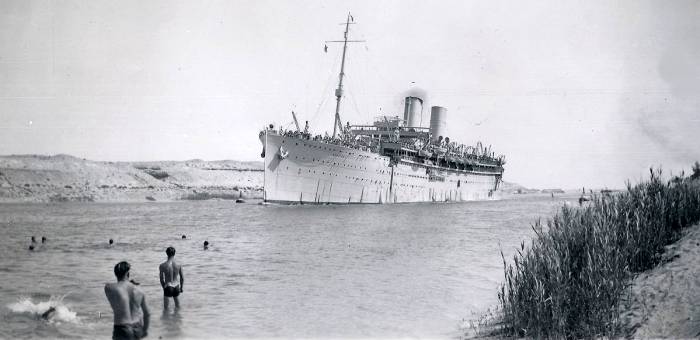
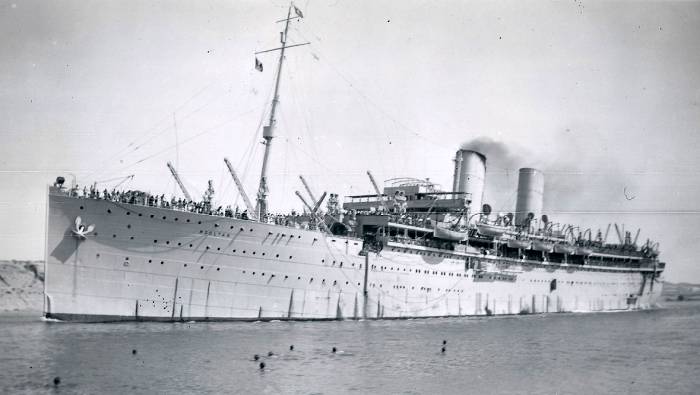
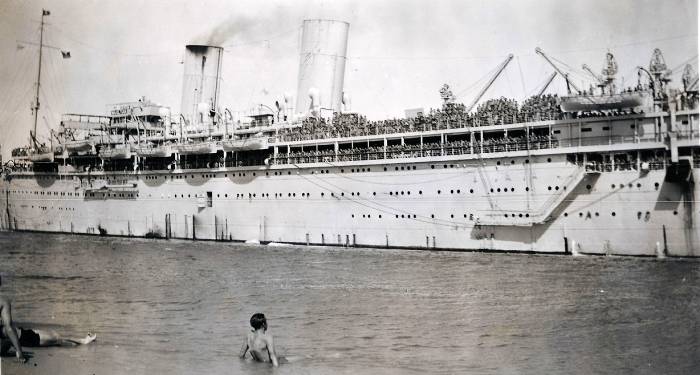
Three Marvellous Photographs
of Mooltan in the Suez Canal, taken in 1946 by a member of the Royal Signals -
name to be advised!

Australian Army soldiers, on board a P&O, West Circular Quay, May 1940 Photo:
Australian National Maritime Museum
She was returned to P & O, after the war, on 16 July 1947,
and completely reconditioned
before being returned to commercial use. On 26 August 1948, she returned to service,
with her tonnage increased to 21,039 gross, and an increased passenger capacity
- 1030 tourist class.
Most of the outward
bound voyages were to Australia, carrying 'Ten Pound Poms' under an assisted passage scheme
established and operated by the Australian government. For the return trip to
the UK, the ship was filled with P & O’s own passengers.
In April 1949 the Mooltan arrived at Tilbury the day after one of her
passengers had died of smallpox. For the next three days, the ship was placed under
quarantine by the port health authority, before any of her passengers or crew
were allowed to disembark. Sadly, during this
period ,five more passengers died.
On 18 November 1953 SS Mooltan slipped out of Brisbane, Australia, on her
last voyage, arriving at Tilbury on 7 January 1954. Her mainly Asian crew
joined the brand new liner Arcadia three weeks later.
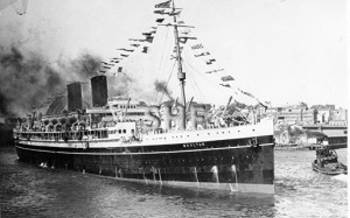
On the 23rd of January 1954, Mooltan was sold for the sum of £150,000 to
the British Iron and Steel Corporation (Salvage) Ltd and sent to Metal
Industries Ltd at Faslane in Scotland, where she was broken up.
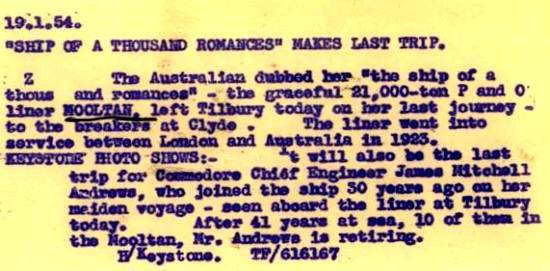
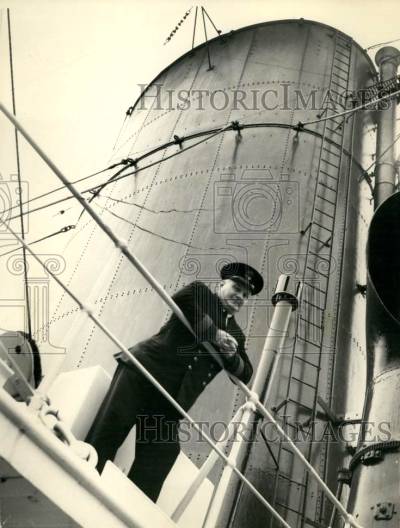
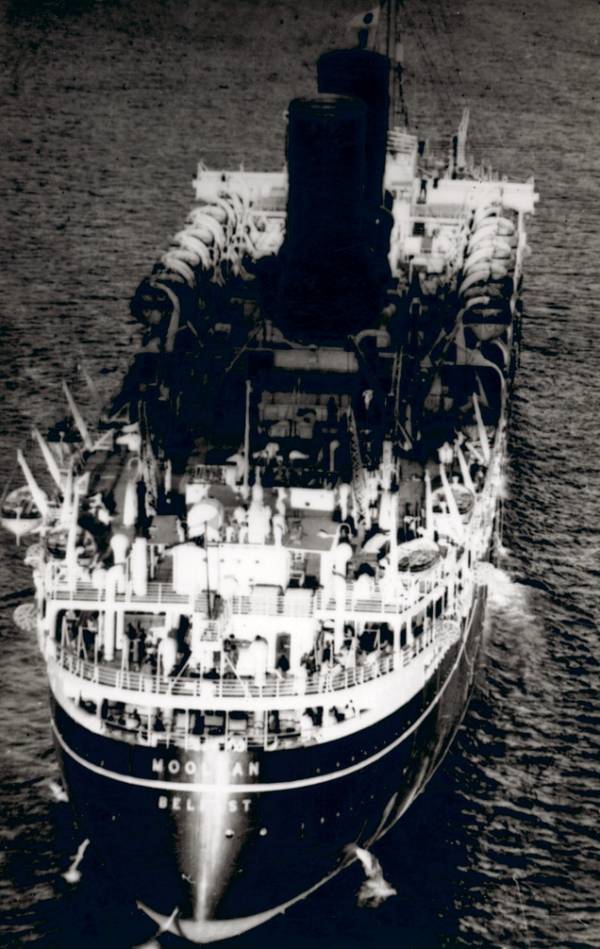
The Mooltan was an exceptional
ship, one with a truly remarkable history. If you have memories of her, or
photographs, please do let me have them for inclusion in her story.

A magnificent model of the
ss Mooltan in the National Maritime Museum, Greenwich. The model is located in
the 'Trade & Empire' gallery.
Photo by:
Malcolm George Heppolette

The Mooltan Ball of 1930
13 May 1930 The Brisbane Courier ~ The Creche and Kindergarten Association have made arrangements with
the P. and O. Co. for a ball to be held
on R.M.S. Mooltan on the evening of
Tuesday, August 12 (during Show
Week), in aid of the funds of the association. A preliminary meeting of
ladies was held at Macdonald, Hamilton, and Co.'s office yesterday (at which
Mr. M. J. Scott presided) to discuss
the steps necessary to ensure this
gathering being a success. Mrs. A. E.
Moore was elected president of the ball
committee. It was decided to call
a meeting of representatives of the
various Creche and Kindergarten
branches and others interested, to be
held at Lennon's Hotel at 10.30 onFriday, May 23. In addition to his
Excellency the Governor and Lady
Goodwin the Governor-General is ex-
pected to attend the Mooltan ball)





























































